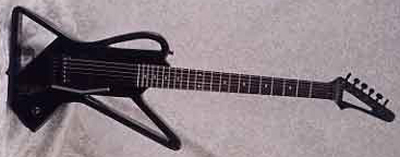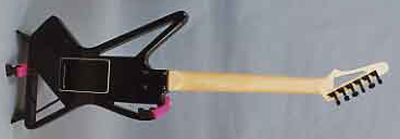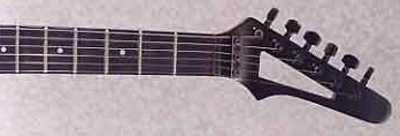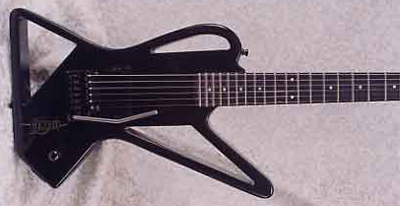When Darcy Kuronen, the musical instrument curator at the Museum of Fine Arts in Boston, contacted me in early 1999 about their upcoming exhibition of guitars as art, which eventually became the Dangerous Curves exhibition, I was psyched. Guitars as art is my credo, why I collect. Well, at least one of the reasons. After a lot of sifting and winnowing, we agreed on a list that included a bunch of my guitars and a hyper-suspensioned, climate-controlled art moving van showed up to spirit my pretties up to Beantown. My Aria Pro II Urchin Deluxe became the visual emblem of the show, on the catalog cover, billboards, bus signs, banners. Pretty cool! Tucked away at the bottom of the pile was this 1985 Schecter Genesis G6 Illusion guitar!

1985 Schecter Genesis G6 Illusion Electric Guitar
The exact origin of this Illusion is shrouded a bit in mystery, despite the “transparent” nature of the design! So, everything I say here may be jumbled up and there are probably a lot of missing pieces, no pun intended. (Well, yes it was!) Here’s what seems to be the story.
Schecter. The genesis of Schecter guitars goes back to mid-1970s. In around 1976 or so Dave Schecter started Schecter Guitar Research. Could have been a little earlier. Schecter was into replacement pickups and pickguards, plus some other parts. This was at a time where dissatisfaction with CBS- quality control at Fender was a problem for fans of Stratocasters. A cottage industry sprang up in aftermarket upgrades and do-it-yourself parts. One of those was a shop run by Wayne Charvel, opened in ’74. He graduated to manufacturing in ’76 and shortly thereafter was hooked up with Schecter. Business problems separated Schecter and Charvel, the latter going on to selling out to Grover Jackson and becoming one of the big names of the ’80s. Schecter continued on as a partser until the mid-’80s, when it, too, began marketing guitars, some of them pretty fine.

1985 Schecter Genesis G6 Illusion Electric Guitar
Ok. Shift to Guild guitars. Begun in the early 1950s by Al Dronge out of the leftovers from the collapse of Epiphone, Guild had a long tradition of solidbody electrics dating to the early ’60s that always managed to remain on the fringes of professional acceptance. Like their dreads, really good but not a Gibson or Martin. By the ’80s Guild electrics had become really, really good, but less and less competitive with brands like Jackson, Charvel or Kramer.
In 1984 a guitar designer named Dave Andrews of David Andrews Guitar Research developed a Jazzmaster-shaped guitar that was basically an X-shaped structure with lots of the wood cut out. This had a glued-in neck. This got a lot of guitar press at the time. He licensed this design to Guild, which introduced the neat X-100 Bladerunner, of which only 95 were ever made through 1985.

1985 Schecter Genesis G6 Illusion Electric Guitar
In 1985 Schecter introduced its first guitar line with this bolt-neck Genesis model. It was supposedly based on a design by one Bill Reed and Chip Todd. Chip was the designer who worked with Hartley Peavey to develop the Peavey T-60 (T for Todd), the world’s first numerical carving machine guitar. Looks like a rip-off of the Guild to me, and there’s probably a lot more to this story.
Anyhow, this is a cool guitar, lightweight, and hot. While it only has one humbucker, the tone pot is a push-pull coil tap. A real solidbody version was also offered by Schecter. The Schecter Genesises were only offered for about a year. More conventional Schecters followed, as did some more unconventional ones, like the Schecter Yngwie Malmsteen! And whatever you think of the current offerings.

1985 Schecter Genesis G6 Illusion Electric Guitar
Once this guitar got to Boston, the show designers kind of fell out of love with the Genesis. It didn’t get featured in the main exhibition, but was minimalized, as it were, to a hanging in the cafeteria area. Still, how many guitars get featured anywhere in a world class art museum? Or represent the beginning of a guitar line with a strange pedigree like this one?!

I actually designed the Schecter Genesis Guitar for Schecter in 1985. I built 2 prototypes for, I believe, Bill Reed, while they were in Dallas TX. I had formerly worked for Mossman Guitars in Kansas and Gruhn Guitars in Nashville. Right after I built the Genesis Prototype(s) I purchased Mossman Guitars and moved it to Dallas, but at the time I had a small shop in my apartment in Oak Cliff where I designed and built the first ones. My payment from Schecter for the work was to receive two of their top of the line guitars. One was a black Tele with binding and the other was a Strat finished like a 50’s style cream Tele finish and their version of a locking whammy. I recently moved from Denver to Athens Ga and am currently building guitars there. I have recently built instruments for: Mick Jones, Patterson Hood, Mike Cooley, Booker T. Jones, Luther Dickinson, John Neff, Justin Townes Earle, and others. In the past I have built guitars for: Carl Perkins, James Burton Chris Hillman, Travis Tritt, Jorma Kaukonen, Willie Nelson, and many others.
If you look at my current electric headstock you can see the resemblance to the Genesis as I used a variation of my headstock for that model. I will soon have a website at: http://www.baxendaleguitar.com but I you can now see my stuff at: http://www.myspace.com/badbax123
I actually have one these guitars. Exactly the same, everything! I can’t find anyone to value it as I live in Ireland, do you know any information of how much they’re worth?
Would anyone be able to tell me anything about a Schecter Genesis guitar in hot pink/white. I have had it since I was a kid and it is in near perfect condition. I am looking into the possible value. I contacted Shecter directly but they said all records prior to 1991 were destroyed due to the company changing hands so many time from 1981-1991.
I would love any information I could get. From one thing I did manage to find on the internet someone sold one for thousands of dollars.
Any help would be appreciated.
Thank you
I had a pink Schecter in the early to mid 80’s that was hot pink with black hardware. It did not say “Startegy” on the headstock. It just said “Schecter”.
We these known as Startegy’s? or some other model?
I’d like to see another like mine and perhaps purchase one again for nostalgia.
I have a white solid body G6 Illusion. I have seen quite a few of the cut-away models, but not many of these. Are they worth anything?
Hey All I have a Shecter Genesis G6 Illusion for sale. Black and Read. Has a few nicks but in really good shape other wise. Asking $500. Contact the shop in Santa Cruz at (831) 458-2438.
Anybody remember the Genesis decal on the body of the guitar. I have one but decal has wore off
i owned 5 of these with different configuartions as well as 3 guild bladerunners. one of which was thee first prototype